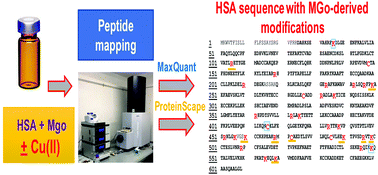Effect of Cu(ii) on in vitro glycation of human serum albumin by methylglyoxal: a LC-MS-based proteomic approach†
Abstract
It has been reported that glycation of human serum albumin (HSA) changes its capability for copper binding whereas the increase of free copper might have an impact on protein glycation – a key process in diabetes progression. In this work, proteomic analysis of non-glycated HSA and HSA glycated with methylglyoxal (MGo) in the absence or in the presence of Cu(II) (0.1; 1.0; 5.0 mg Cu L−1) has been undertaken. Trypsin hydrolysates were subjected to capillary HPLC-ESI-QTOF-MS and MS/MS. Raw data were analyzed using two proteomic platforms: MaxQuant (http://maxquant.org/) and ProteinScape (Bruker). Considering seven MGo-derived modifications, the sequence coverage was 98% for non-modified HSA and ≥93% for HSA incubated with MGo or MGo + Cu(II). Peptide mapping yielded 76 identical peptides in all samples though important differences were found between non-modified HSA and protein glycated with or without Cu(II). Overall, 46 peptides with residues from 1 to 3 modified were detected/sequenced; the MGo-derived modifications found were: hydroimidazolone, argpyrimidine, Nε-carboxyethyl-lysine and S-carboxyethyl-cysteine; 39 modified sites were identified (22 on arginine, 12 on lysine, and 5 on cysteine) and among them, 27 were common for ProteinScape and MaxQuant. The count of the modified peptides and the comparative analysis of their abundance in different samples indicated that Cu(II) at physiological and sub-physiological concentrations inhibited HSA glycation as compared to the glycation of the Cu-devoid protein; at higher concentrations (5 mg Cu L−1), this inhibitory effect tends to be inverted. The results obtained suggest that increased protein glycation might be associated with Cu-deficiency and with excessive Cu(II) concentrations, calling for more detailed studies performed on real-world samples with a strict control of copper concentration.

- This article is part of the themed collection: In memory of Joe Caruso


 Please wait while we load your content...
Please wait while we load your content...